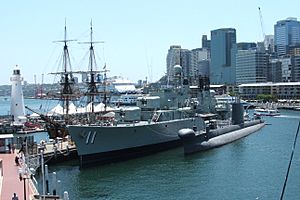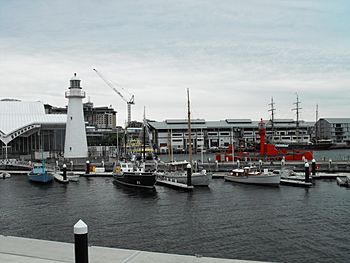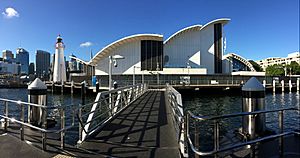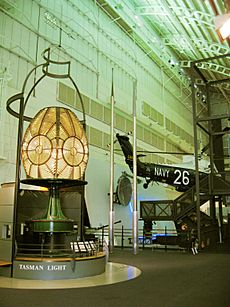Australian National Maritime Museum facts for kids

Australian National Maritime Museum
|
|
| Lua error in Module:Location_map at line 420: attempt to index field 'wikibase' (a nil value). | |
| Established | 1991 |
|---|---|
| Location | Darling Harbour, Pyrmont, Sydney, New South Wales, Australia () |
| Type | Maritime museum |
| Architect | Philip Cox, Richardson Taylor & Partners |
| Owner | Department of Communications and the Arts |
| Public transit access |
|
The Australian National Maritime Museum (ANMM) is a cool place in Darling Harbour, Sydney. It's a maritime museum run by the Australian government. This museum helps us learn all about Australia's connection to the sea.
The idea for the museum started many years ago. The government decided to build it in Darling Harbour. This was part of a big plan to make the area better for Australia's 200th birthday in 1988. The building was designed by Philip Cox. It was supposed to open in 1988, but there were some delays. The museum finally opened its doors in 1991.
The ANMM is one of six museums run by the Australian government. It's special because it's the only one not located in the capital city, Canberra. The museum has seven main areas. These areas show how Indigenous Australians relate to the sea. They also cover how people explored Australian waters. You can learn about how people traveled to Australia by sea. And you can see how the navy defends the country. There are also four extra spaces for special exhibits that change over time.
You can even explore four amazing museum ships! These include a replica of the HM Bark Endeavour. There's also the destroyer HMAS Vampire and the submarine HMAS Onslow. Plus, you can see a copy of the Duyfken. Smaller old boats are also outside, but you can't go inside them.
Contents
History of the Museum
The Australian National Maritime Museum is managed by the government department that looks after communications and arts. It's one of six museums directly run by the Australian government. The others are in Canberra.
How the Museum Started
In 1985, the government announced they would build a national museum. This museum would focus on Australia's history with the sea. It would also show how important the sea still is to the country. People had been thinking about this idea for a few years.
The Premier of New South Wales, Neville Wran, helped make sure the museum was built in Darling Harbour. This was part of a big plan to make Darling Harbour a popular place. Both the Australian government and the New South Wales government thought the ANMM would be a major attraction. They believed it would help the area become very successful.
The museum building was designed by Philip Cox and his team. The roof looks like big, billowing sails. It's over 25 meters tall on one side and much lower on the other.
Building the museum had some challenges. There were changes in leadership and budget cuts. The museum had to rely more on hired staff and volunteers. A large donation from the United States helped create a special gallery. This gallery showed the connections between the US and Australia. Many staff and research areas moved to a nearby building because of this.
The museum was supposed to open in 1988. But construction delays pushed the opening to 1989. The project also went over budget. The building was finished in 1989. The cost had grown to $70 million. There were disagreements about who should pay the extra money. New South Wales ended up paying the additional funds. The museum building was given to the Australian government in 1990. Finally, the Australian National Maritime Museum opened on November 30, 1991.
Museum Operations
To help the museum earn money, the government decided to charge an entry fee. This made it the second national museum in Australia to do so. The entry fee for the museum itself was removed in 2004. However, you still had to pay to go on the museum ships. The entry fee for the museum was added back in December 2011.
In its first ten years, the museum welcomed 3.3 million visitors. That's a lot of people!
In 2010, a newspaper in London called The Sunday Times listed the ANMM as one of the "World's 10 Coolest Museums."
In 2014, the museum announced it would build a new area. This area would show exhibits about the Royal Australian Navy. This new pavilion, called "Action Stations," opened on November 8, 2015. It is located near the navy ships at the museum.
In 2019, the museum updated its look and logo. A design company helped create a new, simpler logo. This new look was used on staff uniforms, ads, signs, websites, and the museum's magazine.
Museum Directors
| Order | Officeholder | Position title | Start date | End date | Term in office | Ref |
|---|---|---|---|---|---|---|
| 1 | Kevin Sumption | Director | 2012 | February 2022 | ||
| 2 | Daryl Karp | Director | 4 July 2022 | present |
Galleries and Vessels
Museum Galleries
The museum has several permanent exhibitions. Each one has a different theme:
- Shaped by the Sea: This gallery explores the very long history of the sea. It shows the deep connections between Indigenous Australians and the ocean. A special video art display called Dhaŋaŋ Dhukarr is at the center. It reflects the themes of this gallery.
- Passengers: This area looks at all the different journeys people made to Australia. It covers everyone from the first settlers to war brides, refugees, and even cruise ship visitors.
- Navy: This gallery shows the important role of the Royal Australian Navy. It also covers earlier naval forces in defending the country. You can see a working steam engine from a navy ship. There's also a figurehead from an old colonial naval vessel. A Sikorsky S-70B-2 Seahawk helicopter hangs from the ceiling!
- Under Southern Skies: This exhibition explores how different navigators explored and mapped the waters around Australia. This includes Aboriginal Australians, Makassan traders, Polynesian seafarers, and European explorers.
The museum also has four other gallery spaces. The Tasman Light gallery holds the original lenses from the Tasman Island Lighthouse. This space is used for photo exhibits and events. The other three galleries are used for temporary exhibitions.
Many other cool items are on display inside the museum. These are not part of a specific gallery. You can see Spirit of Australia, a motorboat that holds the water speed record. There's also an anchor from HMS Sirius. This was the main ship of the First Fleet. You can also see Blackmores First Lady. This boat was used by Kay Cottee, the first woman to sail solo around the world without stopping.
Museum Ships
The Australian National Maritime Museum has four main ships you can explore. These are the HM Bark Endeavour Replica, the destroyer HMAS Vampire, the submarine HMAS Onslow, and a replica of the Duyfken. The old sailing ship James Craig is also nearby. You can tour it with a museum ticket.

In the 1980s, people suggested building a copy of James Cook's ship, the HM Bark Endeavour. Building started in 1988. But the company funding it had money problems in 1990. A special trust was set up in 1991 to finish the ship. The replica Endeavour was completed in 1994. It sailed around Australia and the world for ten years. In 2005, it became part of the museum's collection.
The HMAS Vampire (D11) is a special destroyer. It's the only ship of its kind that has been saved. It was the last gun-destroyer to serve in the Royal Australian Navy. Vampire joined the navy in 1959 and served until 1986. It was loaned to the museum when it opened in 1991. The museum fully owned it by 1997.
The HMAS Onslow is a submarine that joined the navy in 1969. It was used until 1999 and then given to the museum. Even though Vampire and Onslow are no longer active navy ships, they are allowed to fly the Australian White Ensign. Before Onslow, a former Russian submarine was on display from 1995 to 1998.
A replica of the Duyfken joined the museum's fleet in 2020. The original Duyfken was a Dutch exploration ship. It was the first European ship known to visit Australian shores. You can explore this replica ship. It also offers regular cruises around Sydney Harbour.

Other boats you can see at the museum (but not go inside) include:
- HMAS Advance: This was a patrol boat used by the navy to guard Australia's northern waters. It served from 1968 to 1988. It can still be operated today.
- Akarana: A racing yacht from New Zealand. It was restored as a gift for Australia's 200th birthday.
- Bareki: The last wooden tugboat used by the NSW Maritime Services Board. It was built in 1962 and helps the museum with towing.
- The lightship Carpentaria: This was like a floating lighthouse. It was built between 1916 and 1917. It worked in different parts of Australia until 1983.
- John Lewis: One of the last boats used for pearling in Australia.
- Kathleen Gillett: A special yacht that competed in the first Sydney to Hobart race. It was the second Australian yacht to sail around the world.
- MV Krait: A fishing boat used in World War II for a secret mission. It was found again in 1962 and is now on loan to the museum.
- Sekar Aman: An Indonesian perahu (a type of boat).
- Tu Do: A Vietnamese boat used by 31 refugees to reach Australia in 1975 after the Vietnam War.
- MB 172: A former navy officer's launch built in 1937. It is still used to transport museum staff and guests.
Other Cool Spots

The Cape Bowling Green Lighthouse was built in 1874. It was moved to the museum site in 1987. It used to be near Townsville, Queensland.
The Vaughan Evans Library is the museum's research library. It collects information about maritime topics.
The Welcome Wall is a bronze wall on the north side of the museum. It lists the names of immigrants who came to Australia by sea. You can apply to have a name added to the wall for a fee. In 2021, the wall had over 30,000 names! It is now known as Australia's "National Monument to Migration."
There's also a special safety lifeboat and its launching equipment. This type of lifeboat is used on oil rigs and tanker ships. It's used by a local college for maritime training.
The Australian Maritime College also runs some advanced programs from the museum area.
Other Collections
The museum has over 1,000 performance objects from the Bardi people. These are called ilma. The Bardi are an Australian Aboriginal group from Western Australia. These objects were not yet on public display in 2018.
See also



